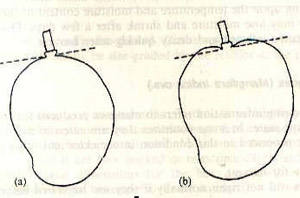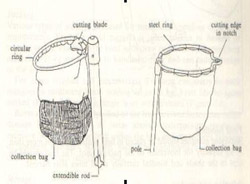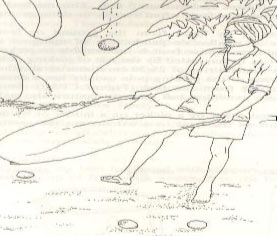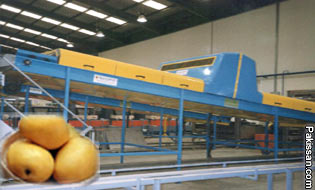|
Post Harvest Handling of
Mangoes
By Muhammad Iqbal
|
 |
|
Currently
working as Chief Operating Officer Pakistan Horticulture
Development & Export Board, He has served the Federal
Government in different positions starting from mid
management to senior management for 30 years. Prior to
current position, he was serving FAO. He has attended a
number of national and international workshops, seminars
and expert consultations and has authored over 70
technical/research publications. |
Post - Harvest Handling System
Mangoes can be successfully stored for up to three weeks if
the recommended harvest maturity, post harvest handling and
storage conditions are employed.
Harvest Maturity
All mangoes to be exported by air should be harvested in the
physiologically mature, hard, green condition. Harvest
maturity in most varieties is judged by the position of the
shoulders in relation to the position of the stem as
illustrated thru
Figure 1:
Figure
1: There is no sure way to know when mangoes are ready for
harvest. One of many methods is this: in immature fruit, the
shoulders are below the level of attachment of the stem (a);
in mature fruit, the shoulders have risen above the
stem-attachment level (b). This method does not apply to all
the cultivars and must be considered with other factors
Half mature fruits may be included in the shipment, but should
not make up more than 25% of the total. Fruit harvested in
ripe condition or with more than 15% yellow coloration, should
be selected in the field and not included in export shipments.
Ripe fruits are highly susceptible to bruising and mechanical
damage during handling and transport. Immature fruits should
not be shipped.

For mangoes exported by sea, the optimum stage of harvest
maturity is the half mature stage. Fruits should not show
any signs of softening or de-greening yellow colour
development. Immature fruits shout not be shipped.
Assessment of Harvest Maturity
in Mangoes
The following descriptions are appropriate for Sindhri &
Chaunsa and for other varieties which show similar
morphological characteristics.
Fully mature: outgrown shoulders, formation of a depression
with ridges at the stem end, firm and green;
Half-mature: shoulders in line with the slightly ridged
edges, firm and green;
Immature: shoulders below the stem insertion with ridges
absent, firm and green.
The maturity can also be determined by putting the fruit in 2%
salt solution. Those that sink are considered mature while
those that float are considered immature.
Harvesting
Where possible, mangoes should be harvested by hand from the
ground, by snapping the mangoes from the stem. Fully mature
fruit will detach easily, whereas half-mature fruit will not.
Optimum harvesting involves using secateurs and cutting the
stem 2 - 3 cm away from the fruit, and the latex allowed to
drain (this technique reduces latex exudation and staining and
reduces the possibility of entrance of fungal organisms).
Later the stem should be further trimmed with a sterilized
knife (dipping in a solution of calcium hypochlorite) to 0.5
or 0.3 cm as demanded by the importer. Where harvesting by
hand from the ground is not possible, harvesting implements
should be used. The most suitable involves a long pole with a
cutting blade and a small bag under the blade to catch the
fruit
(Figure 2).
(a) (b)
 Figure 2:
Picking poles are used to harvest mangoes which cannot be
reached from the ground or ladder. Both the factory-made (a)
and home-made (b) types have cutting device and a catching bag Figure 2:
Picking poles are used to harvest mangoes which cannot be
reached from the ground or ladder. Both the factory-made (a)
and home-made (b) types have cutting device and a catching bag
Alternatively, climbers may use cotton bags which are filled
and lowered to the floor. Mangoes should never be knocked from
the tree, dropped or thrown to the ground. Least option will
be that climber throws fruit which is held on sack and then
gently released to the floor
(Figure 3).
Figure 3:
Mango-picker in the tree drops the fruit, and catcher breaks
its fall using a jute sack supported by his hands and one
foot. He then lowers the bag to ground level and the mango
rolls out without damage
The out-grading should be carried out in the field to remove
immature, undersized, damaged, bruised, scald or ripe fruit.
The fruit on any one tree are of different ages because
flowering and pollination occurs over a period of several
weeks. Therefore, all the fruits do not mature simultaneously.
Fruits are usually harvested from individual trees on several
occasions throughout the season. damaged, bruised, scald or ripe fruit.
The fruit on any one tree are of different ages because
flowering and pollination occurs over a period of several
weeks. Therefore, all the fruits do not mature simultaneously.
Fruits are usually harvested from individual trees on several
occasions throughout the season.
After harvesting, latex should be allowed to drain away from
the fruit and the fruit placed in plastic field crates. Bags,
sacks and buckets are to be avoided as these generally result
in mechanical damage and bruising. Harvested mangoes should
not be left in direct sunlight, wind or rain, either in the
field or during transport from the field to the packing
facility.
Field
Heat Removal
The field heat of the fruit should be removed soon after
harvesting. It is essential for improved shelf life of
mangoes. Different methods can be applied for removing field
heat. These include air cooling, hydro-cooling, vacuum cooling
and forced air cooling. However, in our situation hydro
cooling is most appropriate and practical method. The fruit
should be immersed in ice cold water in field crates or in
bulk. The use of shower-type hydro cooler will be more
appropriate. Addition of sodium hyperchlorite (100 ppm) in
water will help in removing debris and latex stains.
Grading and Packing
On arrival in the packing area, the mangoes should be graded
for removal of immature, under-sized, damaged, blemished,
bruised, infested or ripe fruit. Fruits should be graded in
each carton according to the variety, size (giving a range of
counts for each shipment) and maturity (firm green full-mature
and half-mature fruits will ripen at different rates and
should not be packed in the same carton).
When packing, fruits should be placed leaning to the side
rather then directly on the base. Mangoes should be packed in
single layer one - or two - piece fully telescopic,
self-locking fiberboard cartons (bursting strength
requirements 250-275 lb/in2). Ventilation and handle holes are
recommended to provide adequate ventilation and ease of
handling. Cartons labeling requirements for the individual
markets should be followed. A layer of shredded paper in the
base of the carton is recommended, as this will assist in
cushioning the fruit. Each alternate mango in a carton should
be wrapped in a tissue to reduce fruit to fruit rubbing; small
identity labels attached to alternate fruit will assist in
product presentation. Net weight requirements are 2, 3, 4, 5 &
7 kg depending on the market destination. Cartons must not be
over-filled during packing.
Unitization
Palletisation is essential to minimize fruit damage due to
multiple handling. Movement of fruit within pack-houses or
during temporary storage can be aided by palletisation. For
sea-shipment exports of mangoes, palletisation is a necessity.
Pre-cooling
If mangoes are to be exported to the destination within two to
three days of harvesting, as with air-shipments, then
pre-cooling is advisable but not essential. Mangoes
transported by sea should be pre-cooled prior to loading into
containers or holds. Several methods of pre-cooling are
available, and the system adopted should suit the specific
requirements and capabilities. Temperature controlled rooms
are the most simple, although cooling may be slow if stacking
and spacing are not adequate to allow free and even air flow
or if the refrigeration capacity is low. A forced air system
is more efficient, although this requires a specially designed
unit and compatible packaging. Mangoes should be cooled to a
minimum of 120C.
Ripening and Storage
For export of mangoes by air, storage ripening may be required
prior to shipment. Recommendations for the optimum temperature
for ripening of mangoes vary according to the variety and
growing conditions although the range of 200 to 250C is
usually considered optimum. Temperatures above 250 to 300C may
result in ripe fruit with off-flavours and mottling of the
peel. Initiation and synchronization of ripening period of
mangoes can be achieved with exposure to ethylene gas, whether
direct from cylinders or as liberated from ethephon when
utilized with a catalytic generator. Acetylene gas liberated
from calcium carbide exhibits similar effect. Treatments with
gases are carried out in air-tight room from 24 hours at 200
to 250C, 90 to 95% relative humidity. Concentrations of gas
required during exposure are 10 -100 ppm (0.001 - 0.01%) for
ethylene and 1000 ppm (0.1%) for acetylene. Concentrations of
gases are controlled by adjusting flow deliveries or the
volume of ethylene delivery liquids (such as ethephon).
Air-tight rooms should have adequate air circulation to enable
uniform distribution of gas throughout the room. Build-up of
carbon dioxide is to be avoided as this reduces the effect of
the ethylene and will have a detrimental effect on fruit
ripening.
 Prolonged storage of more than three to five days should not
be used for air-freighted fruit. Prolonged storage should be
used in the case of sea-freighted mangoes. At storage
temperatures below 120C unripe mangoes will develop chilling
injury, which will lead to a drastic reduction in fruit
quality and increased spoilage. Storage at 120C with 85-95%
relative humidity will maintain the fruit in an acceptable
condition, and which will ripen satisfactorily on transfer to
higher temperatures. These criteria depend on the variety,
harvest maturity and the time of harvest in the season. Fully
mature fruits have been found to show a reduced storability
when compared to half-mature fruits, and this factor becomes
more important as the season progresses. Strict levels of
quality control in low temperature stored fruit are essential,
as blemishes, bruises, damage and infections will manifest to
a greater degree than when exported by air and marketed
rapidly. The potential exists in stored fruit for high levels
of spoilage and poor quality. Prolonged storage of more than three to five days should not
be used for air-freighted fruit. Prolonged storage should be
used in the case of sea-freighted mangoes. At storage
temperatures below 120C unripe mangoes will develop chilling
injury, which will lead to a drastic reduction in fruit
quality and increased spoilage. Storage at 120C with 85-95%
relative humidity will maintain the fruit in an acceptable
condition, and which will ripen satisfactorily on transfer to
higher temperatures. These criteria depend on the variety,
harvest maturity and the time of harvest in the season. Fully
mature fruits have been found to show a reduced storability
when compared to half-mature fruits, and this factor becomes
more important as the season progresses. Strict levels of
quality control in low temperature stored fruit are essential,
as blemishes, bruises, damage and infections will manifest to
a greater degree than when exported by air and marketed
rapidly. The potential exists in stored fruit for high levels
of spoilage and poor quality.
Shipment Conditions
For air-shipmen, it is preferable, although not essential,
that transport occurs on aircraft pallets rather than in
containers. Shipment in aircraft containers may result in
build-up of heat and ethylene which will accentuate ripening.
For sea shipments, efficient reefer containers should be used
in preference to break bulk system in the hold. Stacking
system should allow for sufficient ventilation to assist in
temperature maintenance.
Potential Post Harvest Losses
Mechanical Damage
Mechanically damaged fruit will normally deteriorate rapidly
and should not be exported. Damaged regions are susceptible to
microbial infection, particularly when low temperature
long-term storage is used. Careful handling should therefore
be used during harvesting and handling operations such as
grading, packing and transportation.
Low Temperature
Storage at temperature below 120C will result in chilling
injury, the symptoms of which include inhibition of ripening,
pitting, internal discoloration, prey scald like discoloration
of the skin, increased water loss, increased susceptibility to
decay and detrimental changes in flavour.
Pathological Factors
Infection by micro-organisms is generally the most serious
cause of post-harvest losses in mango. Disease incidence can
be reduced by good orchard management, pre-harvest cultural
practices, appropriate handling and post-harvest treatment
procedures. Washing in static water tanks will increase
disease incidence due to the increase in inoculums from
infected fruit, therefore, water has to be changed frequently
and contain sodium hypochlorite (100 ppm) and/or suitable
fungicide. Post-harvest applications of specific fungicides
will assist in disease control.
The important diseases and pests
of mangoes include the following:
o Anthracnose (Colletotrtchum gloeosporfofdes) infection
occurs in the leaves, stem, young flowers and fruits. In the
first three, infection results in depressed black circular or
angular lesions; these enlarge and coalesce and affect large
areas. Infections of the fruit are usually latent and manifest
only as the fruit begins to ripen. Anthracnose is
characterized in ripening fruit by small black circular
lesions which gradually enlarge and coalesce as the fruit
continues ripening.
Mangoes harvested from areas or trees which are known to
suffer from anthracnose or for fruit destined for long term
storage, treatment is required in hot water bath (550C for 5
minutes) containing 0.05% Thiabendazole. This technique shows
good control of anthracnose, but generally requires the use of
specialized equipment, as temperature control of the water
bath is essential for the effectiveness and prevention of
fruits damage. After fungicide treatment, the fruit should be
allowed to cool and dry for preparation for grading and
packing.
o Stem end rot (Diplodfa natalensts) is particularly apparent
during low temperature storage. Infection is characterized by
light grey-brown areas in the stem region. Infection is
believed to occur through the cut stem. Disease incidence can
be reduced by leaving 1 cm of stem attached to the fruit.
o Rhizopus rot (Rhizopus oryzae) develops rapidly at 250C and
is characterized by skin splitting and development of course
white mould with black spore heads. Infection takes place
after harvest, usually through mechanical injury. The
incidence can be minimized by careful handling, hygienic
conditions and rapid cooling.
o Jelly Seed is usually found only when the fruit is sliced;
affected fruit show watery translucent tissue around the stone
towards the stem-end which then spreads. The condition is
found in harvested fruit but develops as the fruit ripens. The
only means of control at present is early harvesting, but this
may result in the export of immature fruits.
o Fruit Flies are among the serious quarantine pests and
therefore restrictions are imposed on mangoes imports by many
countries including China, Iran and Japan. Ideally there have
to be less pest prevalence areas combined with recommended
post-harvest treatments to satisfy the importers. The
integrated pest management technique of controlling fruit
flies is world wide accepted and preferred mode. Hence this
needs to be widely adopted. Regarding post-harvest treatments,
the fruit has to be treated by hot water dip, vapour heat
treatment or irradiation. The facilities for hot water dip are
limited while those of vapour heat treatment and irradiation
at experimental scale only. The development of these
facilities on commercial scale is needed.
Post Harvest Handling of Mangoes
Quality Criteria
Market requirements state that
mangoes on arrival should be:
Physiologically mature;
Commencing ripening with 30 to 50% coloration;
Significant area of golden colour on the fruit shoulders;
Relatively firm;
Minimum sugar content of 10%;
Uniform shapes;
Free from disease, decay, sunscald, cracks, bruises, latex
stains, insect and mechanical damage; and
Conform to the weight and size specifications.
Volume sales of mangoes are based on presence of the golden
colour, acceptable size of ripeness for consumption, uniform
size grading, uniform stage of ripeness and the absence of
disease or damage.
Pakistan Horticulture
Development & Export Board.
|
Pakissan.com;
|